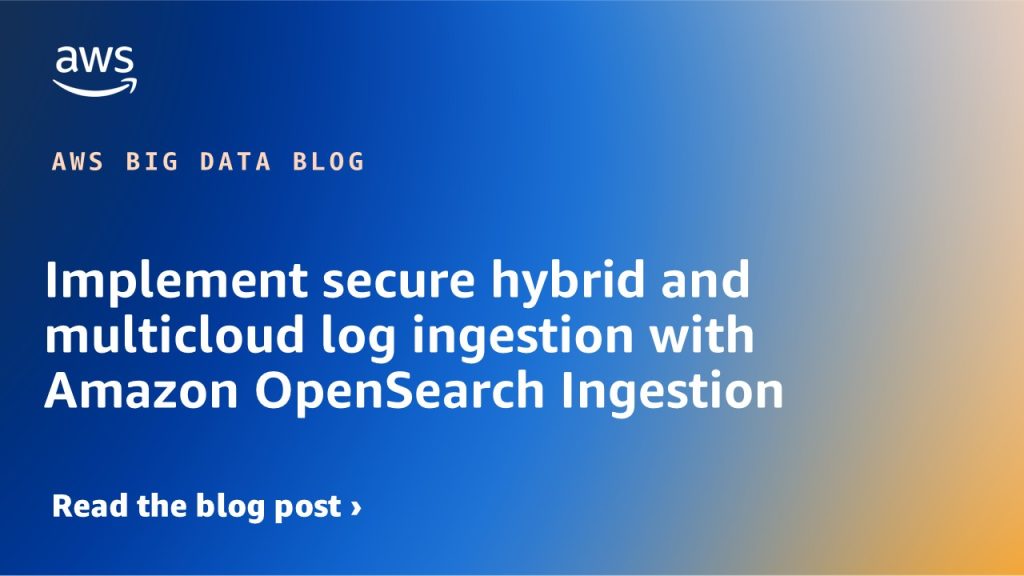AWS Big Data Blog
Category: Intermediate (200)
Amazon OpenSearch Service 101: Create your first search application with OpenSearch
In this post, we walk you through a search application building process using Amazon OpenSearch Service. Whether you’re a developer new to search or looking to understand OpenSearch fundamentals, this hands-on post shows you how to build a search application from scratch—starting with the initial setup; diving into core components such as indexing, querying, result presentation; and culminating in the execution of your first search query.
Implement secure hybrid and multicloud log ingestion with Amazon OpenSearch Ingestion
In this post, we demonstrate how to configure Fluent Bit, a fast and flexible log processor and router supported by various operating systems, to securely send logs from any environment to OpenSearch Ingestion using IAM Roles Anywhere.
Secure access to a cross-account Amazon MSK cluster from Amazon MSK Connect using IAM authentication
In this post, we demonstrate a use case where you might need to use an MSK cluster in one AWS account, but MSK Connect is located in a separate account. We demonstrate how to implement IAM authentication after establishing network connectivity. IAM provides enhanced security measures, making sure your systems are protected against unauthorized access.
Build a multi-Region analytics solution with Amazon Redshift, Amazon S3, and Amazon QuickSight
This post explores how to effectively architect a solution that addresses this specific challenge: enabling comprehensive analytics capabilities for global teams while making sure that your data remains in the AWS Regions required by your compliance framework. We use a variety of AWS services, including Amazon Redshift, Amazon Simple Storage Service (Amazon S3), and Amazon QuickSight.
Reduce time to access your transactional data for analytical processing using the power of Amazon SageMaker Lakehouse and zero-ETL
In this post, we demonstrate how you can bring transactional data from AWS OLTP data stores like Amazon Relational Database Service (Amazon RDS) and Amazon Aurora flowing into Redshift using zero-ETL integrations to SageMaker Lakehouse Federated Catalog (Bring your own Amazon Redshift into SageMaker Lakehouse). With this integration, you can now seamlessly onboard the changed data from OLTP systems to a unified lakehouse and expose the same to analytical applications for consumptions using Apache Iceberg APIs from new SageMaker Unified Studio.
Embracing event driven architecture to enhance resilience of data solutions built on Amazon SageMaker
This post provides guidance on how you can use event driven architecture to enhance the resiliency of data solutions built on the next generation of Amazon SageMaker, a unified platform for data, analytics, and AI. SageMaker is a managed service with high availability and durability.
Powering global payout intelligence: How MassPay uses Amazon Redshift Serverless and zero-ETL to drive deeper analytics.
In this blog post we shall cover how understanding real-time payout performance, identifying customer behavior patterns across regions, and optimizing internal operations required more than traditional business intelligence and analytics tools. And how since implementing Amazon Redshift and Zero-ETL, MassPay has seen 90% reduction in data availability latency, payments data available for analytics 1.5x faster, leading to 45% reduction in time-to-insight and 37% fewer support tickets related to transaction visibility and payment inquiries.
Scalable analytics and centralized governance for Apache Iceberg tables using Amazon S3 Tables and Amazon Redshift
In this post, we’ll build on the first post in this series to show you how to set up an Apache Iceberg data lake catalog using Amazon S3 Tables and provide different levels of access control to your data. Through this example, you’ll set up fine-grained access controls for multiple users and see how this works using Amazon Redshift. We’ll also review an example with simultaneously using data that resides both in Amazon Redshift and Amazon S3 Tables, enabling a unified analytics experience.
How LaunchDarkly migrated to Amazon MWAA to achieve efficiency and scale
In this post, we explore how LaunchDarkly scaled the internal analytics platform up to 14,000 tasks per day, with minimal increase in costs, after migrating from another vendor-managed Apache Airflow solution to AWS, using Amazon Managed Workflows for Apache Airflow (Amazon MWAA) and Amazon Elastic Container Service (Amazon ECS).
Zero-copy, Coordination-free approach to OpenSearch Snapshots
In this blog post, we tell you how we enhanced the snapshot efficiency in Amazon OpenSearch Service while carefully maintaining these critical operational aspects. These snapshot optimizations are enabled for all OpenSearch optimized instance family (OR1, OR2, OM2) domains from version 2.17 onwards.









